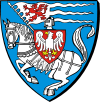Koszalin (parliamentary constituency)
| Koszalin | |||
|---|---|---|---|

Postmodern buildings in Koszalin
|
|||
|
|||
| Coordinates: 54°12′N 16°11′E / 54.200°N 16.183°ECoordinates: 54°12′N 16°11′E / 54.200°N 16.183°E | |||
| Country | Poland | ||
| Voivodeship | West Pomeranian | ||
| County | city county | ||
| Established | 11th century | ||
| Town rights | 1266 | ||
| Government | |||
| • Mayor | Piotr Jedliński | ||
| Area | |||
| • Total | 98.33 km2 (37.97 sq mi) | ||
| Elevation | 32 m (105 ft) | ||
| Population (31 Dec 2014) | |||
| • Total | 108,605 | ||
| • Density | 1,100/km2 (2,900/sq mi) | ||
| Time zone | CET (UTC+1) | ||
| • Summer (DST) | CEST (UTC+2) | ||
| Postal code | 75-900, 75-902, 75-007, 75-016 | ||
| Area code(s) | +48 94 | ||
| Vehicle registration | ZK | ||
| Website | www |
||
Koszalin ([kɔˈʂalʲin]; Kashubian: Kòszalëno; German: Köslin) is a city in Western Pomerania in north-western Poland. It is located 12 kilometres (7 miles) south of the Baltic Sea coast, and intersected by the river Dzierżęcinka. Koszalin is also a county-status city and capital of Koszalin County of West Pomeranian Voivodeship since 1999. Previously, it was a capital of Koszalin Voivodeship (1950–1998). The current mayor of Koszalin is Piotr Jedliński.
Koszalin is first mentioned in 1108 in the Chronicle of Greater Poland (Kronika Wielkopolska) which relates that duke Boleslaw Krzywousty captured and subjugated multiple Pomeranian cities including Kołobrzeg, Kamień, Wolin and Koszalin.
In 1214, Bogislaw II, Duke of Pomerania, made a donation of a village known as Koszalice/Cossalitz by Chełmska Hill in Kołobrzeg Land to the Norbertine monastery in Białoboki near Trzebiatów. New, mostly German, settlers from outside of Pomerania were invited to settle the territory. In 1248, the eastern part of Kołobrzeg Land, including the village, was transferred by Duke Barnim I to the Roman Catholic Diocese of Kammin.
...
Wikipedia



